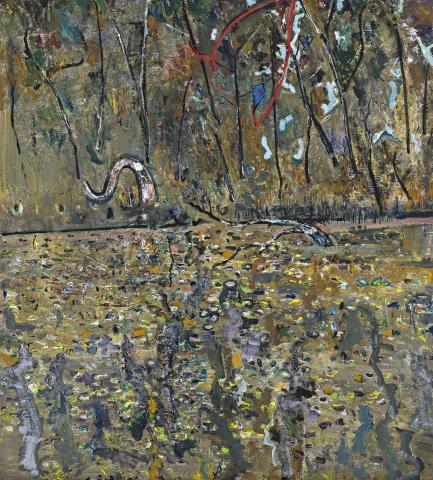BLUE KITE, KEW BILLABONG I (KEW BILLABONG, OLD KITE), 1976
FRED WILLIAMS
oil on canvas
106.5 x 96.5 cm
bears inscription verso: FRED WILLIAMS / KEW BILLABONG, OLD KITE. 1976 / … / UNSIGNED (Lyn Williams)
authenticated by Lyn Williams
The artist's estate, Melbourne
Christies, Sydney, 14 November 1988, lot 272
Carolyn Palliardi, Melbourne, 1996
Lauraine Diggins Fine Art, Melbourne, 1996
Private collection, Melbourne
Lauraine Diggins Fine Art, Melbourne, 1997 (labels attached verso)
Private collection, USA
Private collection, Melbourne
19th & 20th Century Australian Painting, Sculpture and Decorative Arts, Lauraine Diggins Fine Art, Melbourne, 1996, cat. 90
19th & 20th Century Australian Painting, Sculpture and Decorative Arts, Lauraine Diggins Fine Art, Melbourne, 1998, cat. 69
In April 1975, Fred Williams began work on a major series of paintings based on the billabong at Kew, a place within easy reach of his home. In the thirty or more paintings of the series, Williams changed his focus from the broad Australian panorama to the enclosed, intimate view. It was a secluded site, providing Williams with a place of retreat, peace and refreshment, ideal for embarking on a new direction in his art. While the first works were more traditional in terms of descriptive landscapes, the later embraced wider aesthetic interests, as in Blue Kite, Kew Billabong I (Kew Billabong, Old Kite), 1976.
It is not uncommon to compare or liken these Billabong paintings to Claude Monet's Waterlilies series, inspired by his garden at Giverny. The obvious reference to water, flowers, reflections and quietude aside, it is more in the way in which each artist explored ideas and technical possibilities that they complement each other. They also produced transcendentally beautiful works of art. Williams' biographers Patrick McCaughey and James Mollison both comment on his adoption, in this Billabong series, of a more Impressionist approach, mentioning the use of small brushstrokes and interest in bright colour, light and reflections. Mollison continued, 'The surface of the canvas becomes a mosaic of deliberate thick marks of purples, blues and greens '...with flickering accents of rose-pink and orange’.1 The description fits our painting as much as any in the series. Referring to other Billabong works, McCaughey noted the 'light reflecting and refracting on water. Likewise, the deep, purplish-blue tonalities relieved by a lighter, more decorative range of pinks, reds, ochres and aqua greens, found in Monet, are Williams' basic palette for the series. Like Monet at Giverny, Williams had deliberately circumscribed his view and worked into the motif’.2
While the presence of fore and far shoreline, and the blue kite with its brilliant trail of red provide figurative elements, Blue Kite, Kew Billabong I (Kew Billabong, Old Kite) has the appeal of an abstract painting. Plants and the detritus of the city are transformed by deft dabs and strokes of the brush into a lively surface of colour. Through this fluent working of surface paint within a shallow pictorial field, Blue Kite, Kew Billabong I (Kew Billabong, Old Kite) takes on the richness of a tapestry, touched with an Oriental aesthetic and a flavour of the transcendental.
1. Mollison, J, A Singular Vision: the Art of Fred Williams, Australian National Gallery, Canberra, 1989, p. 201
2. McCaughey, P., Fred Williams, Bay Books Pty Ltd, Sydney, 1980, p. 286
DAVID THOMAS
